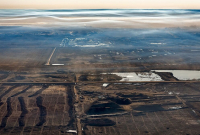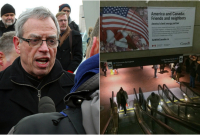The launch of Canada’s first large−scale oilsands mine began on a cold and overcast September day in 1967, with speeches to a crowd of about 600 VIPs predicting incredible wealth would be unlocked from the massive energy resource in northern Alberta.
But veteran employees of the Great Canadian Oil Sands project say that early promise was soon met with harsh challenges, including emergency shutdowns, labour strife, cold weather and biting insects.
George Skulsky, 78, proudly remembers showing U.S. industrialist J. Howard Pew, chairman of project owner Sun Oil and a member of one of America’s richest families, which buttons to push to start process lines at the mine’s official opening.
Skulsky was also on duty during a night shift in the project’s extraction plant a few months later, when the powerhouse boilers all failed and the lights went out, triggering a months−long shutdown.
"It was 40 below outside and ... the whole plant went down cold. Everything froze up," he said. "It cost millions and millions of dollars. They had to replace a lot of equipment to get the plant back up and running."
Skulsky, who spent nearly 30 years working at the mine, also witnessed both its early and later labour struggles.
Early on, the company asked him to help set up a bargaining association for the 300 workers on site. He recalls helping organize a two−day strike in 1969 that forced Sun Oil to reverse a plan to charge workers 10 cents to take the bus to work.
But he had joined management by 1986 when the company had a labour dispute with about 1,100 employees that would last for six months. He was asked to help keep the mine and plant running with non−union staff and employees flown in from other operations.
"It was a tough, mean strike whereby the RCMP were arresting people at the gates and taking them away," he said.
Bert MacKay was also at the mine’s opening day. He recalls then−Alberta premier Earnest Manning giving a "remarkable" speech.
But equally memorable were the project’s many operational issues. They included feed bins constantly jammed by big rocks, a situation cured by the introduction of ore crushers still in use today.
One of the biggest problems was with 850−tonne bucket−wheel excavators imported from Germany. The equipment was used around the world to mine coal, but wasn’t hardy enough for digging the rough oilsands.
"The first set of teeth that came with the wheel had to be changed within 48 hours. That’s amazing," recalls MacKay, 78. "At nighttime, the bucket−wheels digging, you could watch from a distance and see the sparks coming off the oilsands. It was like a welder’s torch but it was simply the abrasive sand and the friction."
He said workers were skeptical about the decision to switch to ore trucks and shovels when the company began a new mine in 1993, but the technology worked better than expected.
Germain Routhier, 89, says he didn’t initially want to work at the mine because of bad experiences while helping build the Fort McMurray highway — he operated heavy equipment with an open cab at the mercy of bitter cold and hungry insects.
But the offer of $2.90 per hour, up from his $2 hourly wage at a construction company, convinced him to come aboard in 1967.
"We had power failures and you name it. That company, I often wondered how could they keep it up. Big fires. You’d swear to God it would be all gone," he said. "Somehow or other they’d fight it, put it out, rebuild it and we’d be back to work."
He and his wife Marie still live in the double−wide modular home originally provided by Sun Oil, which later became Suncor Energy.





Comments